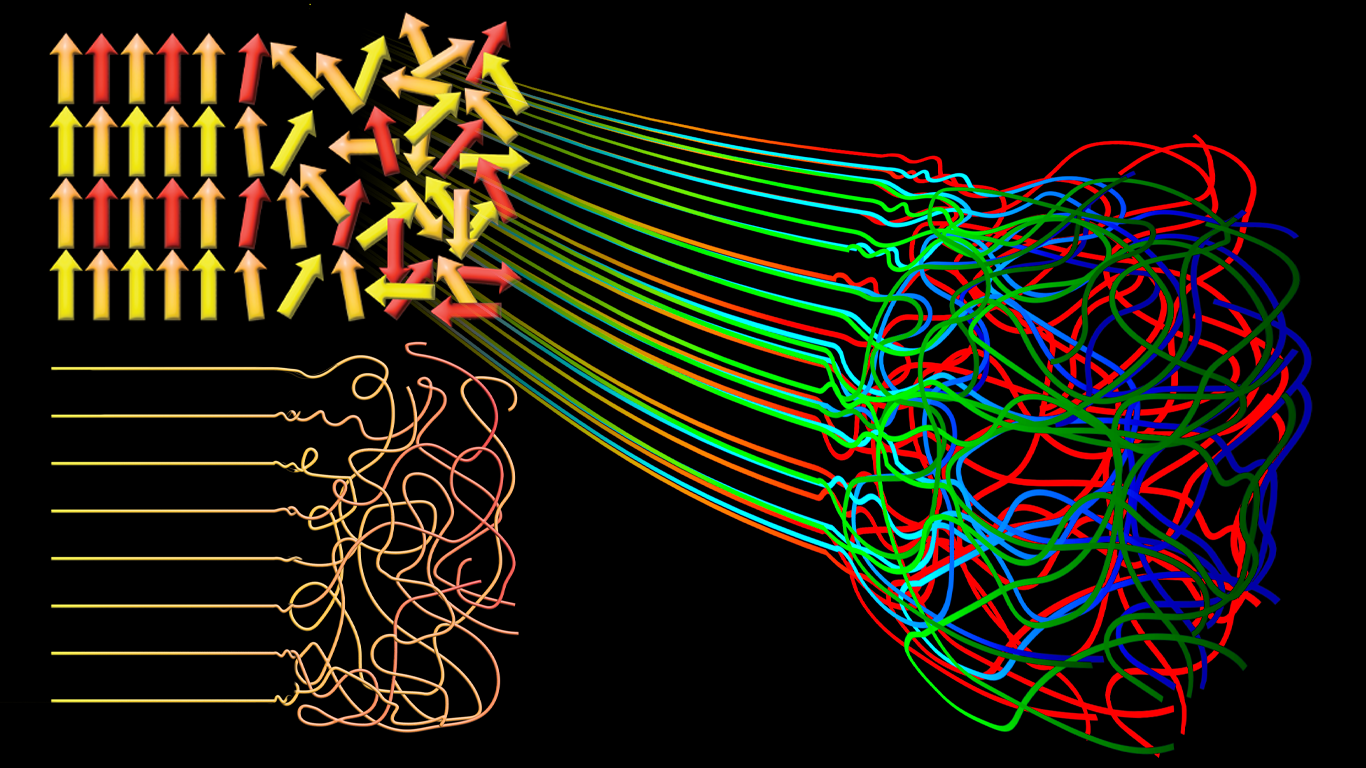A problem in materials design is that in natural as well as artificial materials, volume occasionally drops, or surges, with rising temperature. While there are mechanical reasons for this occurrence for certain materials, a general insight into why this occasionally occurs is still lacking.
 Entropy is the measure of the disorder in a system that occurs over a period of time with no energy put into restoring the order. Zentropy integrates entropy at multiscale levels. Image Credit: Elizabeth Flores-Gomez Murray
Entropy is the measure of the disorder in a system that occurs over a period of time with no energy put into restoring the order. Zentropy integrates entropy at multiscale levels. Image Credit: Elizabeth Flores-Gomez Murray
However, a group of Penn State scientists has formulated a theory to elucidate and then forecast it: Zentropy.
Zentropy is a kind of entropy, a concept fundamental to the second law of thermodynamics that states the measure of the disorder of a system that takes place over a certain duration when no energy is applied to maintain order in the system.
Imagine a play area in a preschool; if no energy is put into maintaining it neat, it rapidly turns into a disorderly mess with toys everywhere, a state of high entropy. If energy is put in through tidying up and arranging the room once the children go away, then the room gets back to a state of order and low entropy.
The theory of Zentropy observes that the thermodynamic relationship of thermal expansion, when the volume rises because of higher temperature, is equal to the negative derivative of entropy concerning pressure, i.e., the entropy of most material systems reduces with a rise in pressure.
This allows Zentropy theory to have the ability to estimate the alteration of volume as a function of temperature at a multiscale level, meaning the various scales within a system. All states of matter have their own entropy, and different components of a system possess their own entropy.
When we talk about the configuration entropy (different ways particles rearrange within a system) that entropy is only part of the entropy of the system, So, you have to add the entropy of individual components of that system into the equation, and then you consider the different scales, the universe, the earth, the people, the materials, these are different scales within different systems.
Zi-Kui Liu, Study Primary Investigator and Dorothy Pate Enright Professor of Materials Science and Engineering, Penn State University
The researchers published their findings in the Journal of Phase Equilibria and Diffusion. They believe that Zentropy may be able to estimate irregularities of other physical properties of phases further than volume. This is because of how reactions of a system to external stimuli are triggered by entropy.
Macroscopic functionalities of materials arise from groups of microscopic states (microstates) at all scales at and below the scale of the macroscopic state of investigation (macrostate).
These functionalities are tough to estimate as only one or a few microstates can be taken into consideration in a standard computational method such as the predictive ab initio calculations, which help establish the key properties of materials.
This challenge becomes acute in materials with multiple phase transitions, which are processes that convert matter from one state to another, such as vaporization of a liquid. This is often where the most transformative functionalities exist, such as superconductivity and giant electromechanical response.
Zi-Kui Liu, Study Primary Investigator and Dorothy Pate Enright Professor of Materials Science and Engineering, Penn State University
According to Liu, the theory of Zentropy “stacks” these diverse scales into an entropy theory that incorporates the various elements of the total system, demonstrating a nested formula for the entropy of intricate multiscale systems.
You have these different scales and you can stack them up with Zentropy theory. For example, atoms as a vibrational property, that's low scale, then you have electronic interaction, that even lower scale. So now how do you stack them together to cover the entire system? So that is what the Zentropy equation is about, stacking them together. It creates a partition function that is the sum of all the entropy scales.
Zi-Kui Liu, Study Primary Investigator and Dorothy Pate Enright Professor of Materials Science and Engineering, Penn State University
This method is something Liu’s lab has been involved in for more than 10 years, with five published research papers.
“The idea actually became very simple after we studied it and understood it,” Liu stated.
Zentropy has the prospect of altering the way materials are developed, particularly those that are part of systems that are subjected to increasing temperatures. These temperatures, specific thermal expansion, could cause problems if the materials expand.
This has the potential to enable the fundamental understanding and design of materials with emergent properties, such as new superconductors and new ferroelectric materials that could potentially lead to new classes of electronics. Also, other applications such as designing better structural materials that withstand higher temperatures are also possible.
Zi-Kui Liu, Study Primary Investigator and Dorothy Pate Enright Professor of Materials Science and Engineering, Penn State University
While there are advantages for society overall, scientists could apply Zentropy to numerous fields. This is on account of how entropy exists in each system.
"The Zentropy theory has the potential to be applied to larger systems because entropy drives changes in all systems whether they are black holes, planets, societies or forests,” Liu said.
Together with Liu, other study authors include Yi Wang, a research professor in materials science and engineering, and Shun-Li Zhang, a research professor in materials science and engineering. The study received support from the National Science Foundation, the Department of Defense, and the Department of Energy.
Journal Reference:
Liu, Z-K., et al. (2022) Zentropy Theory for Positive and Negative Thermal Expansion. Journal of Phase Equilibria and Diffusion. doi.org/10.1007/s11669-022-00942-z.